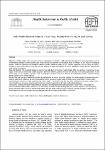Risk-health behavior Patterns in Germany. Results from the GEDA 2009 survey
Lippe, Elena von der
Müters, Stephan
Kamtsiuris, Panagiotis
Objective: Lifestyle-related risks are known to have a strong impact on health. Health outcomes also depend on many other factors, such as environmental pollution and the use of public health services, but another very important factor is lifestyle. In our study we investigate people's health-risk behavior and distinguish between possible behavior patterns in the German population. For our study we make a selection of four human behavior risks and take into account the daily consumption of fruit or vegetables, sporting activity, smoking and risky alcohol consumption. Data and Methods: The empirical analysis is based on the data from the German Health Update 2009. Our analysis is carried out in two stages. At first we use hierarchical cluster analysis to define the different patterns of health-risk behavior in the German population. At the second stage we use a logistic regression model to determine the factors that most influence the individual's behavior, using the already defined clusters of risk-health behavior. Results: Five main groups of health-risk behavior are defined with the help of the cluster analysis. Our results showed that individual healthbehavior patterns are influenced by many demographic factors, but also by people's state of health and by social factors. People's healthrelated behavior is driven to a large extend by their state of health – the healthier they feel, the riskier the behavior they tend to adopt. Good state of health and a young age, together with gender are important preconditions for risky health-related behaviors. Conclusions: Certainly, the health-related behavior is a part of the dynamic and interactive processes of daily living. The changes in a person's individual health-related behavior in the course if his or her life involves looking back over previous experience and anticipating future experience, often in terms of stereotypical realities. The aim of the health preventive programs should be to achieve a high level of health awareness and consciousness among young population and to reduce gender differences in health.
No license information

